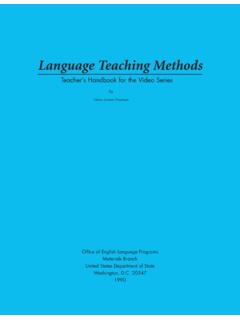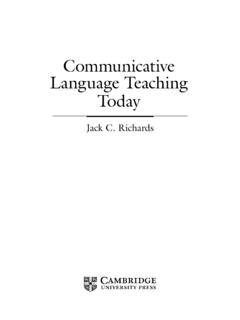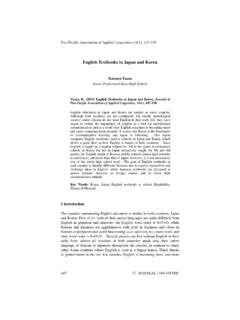Transcription of The Communicative Approach to Language Teaching: The …
1 Infernafional Journal of english Sfudies The Communicative Approach to Language Teaching: The King is dead! Long live the King!' JOHN T. ROBERTS' University of Essex ABSTRACT The purpose of this paper is to argue that though the Communicative Approach to Language teaching in its original sense has long been theoretically dead, it has for an almost equally long time at least potentially existed in a new form, and continues to thrive. By no means here for the first time is this sort of proposal made, but what remains to be done is to firmly pronounce the death of ' Communicative Approach to Language Teaching Mark 1' and to formally welcome, if somewhat belatedly, that is to say, by at least 17 years, its successor: ' Communicative Approach to Language Teaching Mark 11'.
2 At the same time, the attempt to disambiguate ' Communicative Approach to Language Teaching' from ' Communicative Methodology' is made again, because students of Applied Linguistics often reveal a complete failure to grasp the difference, as well as failure to understand why the term 'Cornrnunicative Method' is meaningless. The story related here will be very familiar to some, but less so to others, which is why it is detailed. It is, of course, only one story, one interpretation, and there are others. KEYWORDS: British Communicative Approach to Language teachin'g, Language as a social tool, demand for english , David Wilkins, Council of Europe, Del1 Hymes, John Munby, new directions, proposals.
3 * Address for correspondenre: Department of Language and Linguistics, University of Essex, Wivenhoe Park, Colchester, Essex C04 3SQ, England. Tel.: 00-44-1026-872185. E-mail: O Servicio de Publicaciones. Universidad de Murcia. All rights reserved. IJES, vol. 4 (l), 2004, pp. 1-37 7. John Roherls 1. INTRODUCTION The Communicative Approach to Language Teaching (Mark 1) was first identified in Roberts (1982:97ff, 1983:99ff) as 'the British tradition', an analysis later echoed in Richards and Rodgers (1986:64ff). 'British' in this context is not used jingoistically, but genealogically, to summarise the provenance of the Approach , since, with few outstanding exceptions (eg Van Eck.)
4 Richterich). it was pioneered by British linguists and applied linguists and among these, the name most prominent in the early stages was that of Wilkins, who was one of the first, if not the first, to use the term ' Communicative Approach ' (1 974b). His work for the Council of Europe on the 'common core in a unitlcredit system'*, from which the concepts NOTION and FUNCTION emerged, was crucial to further developments. 11. IDEATIONAL INPUTS AND SOURCES OF INSPIRATION There are at least four factors to be considered here: 1. The viewing of Language as a social tool. 2. The increasing demand for instruction in english . 3. Wilkins's and others' work for the Council of Europe.
5 4. The missing link - the 'aha' experience provided by Hymes. The viewing of Language as a social tool The social role of Language and its place in the 'social process' as a means of cornmunicating meaning were perhaps first hinted at (in the C20) by Firth (1957a,b) but others, including Halliday (1967, 1970a,b, 1973, 1975, 1978), Austin (1962, 1963) and Searle (1965, 1967, 1969), also supplied major contributions to the developing focus on Language as a social tool. The perceptions of linguists do, of course, not infrequently percolate into thought about Language teaching and what the aims of this latter should be. At the same time, it would be naive to think that linguists were responsible more than in some part for shifts of priority in aims.
6 Equally important are social, cultural and political factors. For example, if one considers the emergence of Audiolingualism (for a lucid account, see Rivers 1964), the strongest motivation for its methodological direction and its insistence upon the acquisition of the 'four skills' was connected with the American national interest and the need to forge ties with other peoples in the world in the interests of preventing and resolving conflict (with the United States). Of course, to explain the form and direction taken by Audiolingualism as manifestations of the work of the structuralist linguists and behaviourist psychologists would be legitimate as far as it goes, but would ignore the imperative, the 'cal1 to arms', addressed to these linguists and psychologists to give their al1 to the Army Specialized Training Program in time of desperate national need, and then, later, in peacetime, to develop a programe for high school, in the national interest.
7 The work of William Riley Parker (1961). The National Interest and Foreign Languages, though possibly misinterpreted, was Q Servicio de Publicaciones. Universidad de Murcia. All rights reserved. IJES, vol. 4 (l), 2004, pp. 1-37 The Comniunicafive Approach lo LT 3 undoubtedly seminal here, at least among the politicians. Taking a wide, historical point of view, and aware of the vicissitudes of fashion and other diverse factors involved, Kelly does not see the development of Language teaching aims as following a continuum, indeed he does not really see any 'development' at all, but as a process of cyclic shifting from one of only three universal aims to another: In Language teaching three broad aims can be distinguished: the social, the artistic (or literary), and the philosophical.
8 The first aim demands that Language should be regarded as a form of social behavior and a type of communication. The artistic airn treats Language as a vehicle for creativity, demanding both appreciation of creative activity and creative activity itself .. The philosophical airn demands training in analytic techniques and often confuses linguistics with Language teaching. Kelly (1969: 396fl We cannot, of course, envisage that when the emphasis on one aim shifts onto another, it is a complete shift and that the other aims are abandoned. But what we can say is that this or that aim becomes the dominant one, at least in certain domains and circles able to propagandise effectively their own (allegedly) novel initiative.)
9 For the purposes of discussing the British Communicative Approach to Language Teaching, we might argue that consciousness-raising with regard to the social role of Language created a predisposition among British thinkers about Language teaching of the mid and later 20th century to accept that the teaching of english was to be pursued for social and cornrnunicative purposes, that english was to be regarded as a social tool for the canying out of transactions through Language , the ernpirical consequences of which transactions, however, might be far from linguistic. If we locate the most intensive process of consciousness-raising with regard to english as a social tool as happening throughout the 1960s, we have to observe that outside the then modern english Language Teaching-focused circles, it was the 'philosophical aim' which continued to hold sway in the educational institutions of the Anglo-Saxon world, foreign languages being taught basically by Grammar-Translation.
10 This also applied to the teaching of english and other non-indigenous languages in foreign schools and Universities at that time. Not that school and University authorities were necessarily opposed to the idea of leaming languages for the purposes of communication, but believed, or hoped, that the ability to communicate would graft itself on naturally and without pedagogical intervention to the leaming acquired via a grammatical or situational syllabus. This is no doubt still the case in some if not many countries, despite noteworthy changes of direction in others. However, the 'conscientious-raising' resulting from the work of linguists can only be, as suggested above, a partial explanation for a shift in orientation in certain circles.














